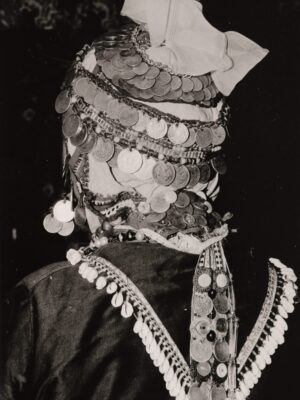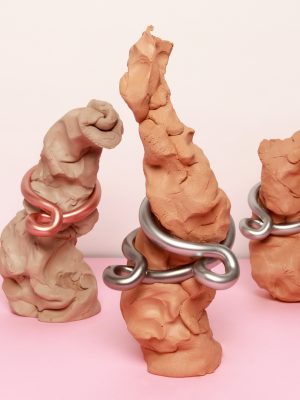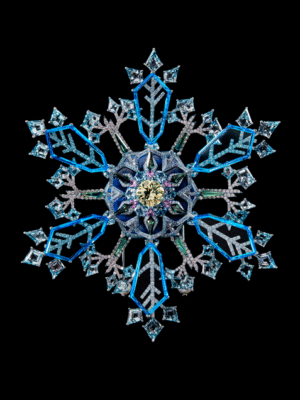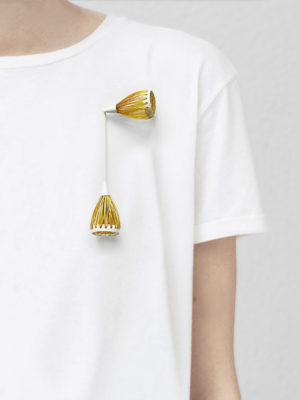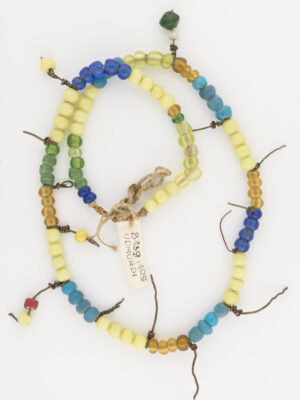
I am after the undocumented jewels. The ones that must have become tangled—I am sure of it—on somebody’s neck. I long to see the pearls that fell beyond the reach of foreign folklorists and nationalist archivists. Thus, I search in images that linger between private memories and masculine archives for beads that were too dull for shiny photographs.
I find images that have been branded into my consciousness through oral history, dripped into me through my grandmother’s false teeth, delivered in the wet thong we share, passed like earrings down the maternal line.
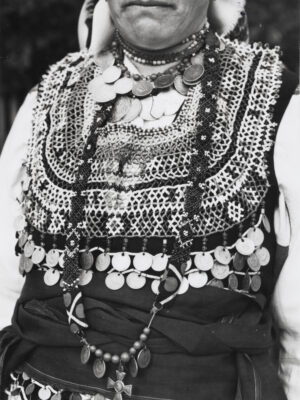
Exhibit number 186781
An armour of bright beads arranged in a mathematical manner, edged with silver sequins, reaches all the way from the tips of the shoulders to the bottom of her breasts, covering the excited nipples that are strapped tight by rough linen fabric. A couple of chokers, pearls of earthy origin, squeeze her muscular neck tightly. Small solar charms dangle from loops attached to her earlobes. A scarf with a floral pattern is tied precisely to cover her hair.
That is all I can see.
No eyes. No context. Not even a nose. Only part of the chin and a mouth pressed tight into a thin line. Hands locked into fists, I imagine.
I assume she had no desire to be framed or photographed, but she did take some enjoyment from the way the photographer’s smooth city hands arranged her body in front of the camera, oddly close to the apparatus.
The decision about whom to photograph was arbitrary. Whoever was willing, first at hand. Whoever had the loveliest smile. For the consistency of his research material, he needed: a single specimen with a set of everyday jewels, one from each village. He explained to her that she needed to stand as still as a wooden chair and joked, ‘Pretend that you are dead.’ She did not laugh, nor object.
Behind the nameless female body, who became exhibit number 186781, stood several curious women, all dressed in an identical manner, yet none of them looking the same. They held tightly to the puffed sleeves of the model. He expected the other women to leave and made that clear to them. The women in the back stayed put, not out of jealousy as he assumed, but because they stood with her, whispering tiny, inseparable words into the thin air. Slowly, a melancholic tune began to form from their voices. The chinking of the sequins followed as their hands tapped on their chests in a rhythmical manner.
He was not there to record their so-called song, if it could even be called music. That was not his area of research nor expertise. Thus, he let that tune slip out of the claws of the recorder. He was here, after all, to execute a clear, simple task—to create a coherent archive of vernacular jewellery among the Finno-Ugric peoples. And that is all he saw.
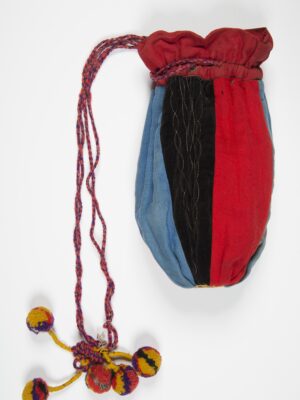
Smoking is a hot, messy national affair
A tobacco pouch made from a cotton-linen blend, worn out and used, with a lilac stain on the faint blue fabric. It’s about the same size as those plastic folders we use these days. It still carries the faded smell of dry tobacco and other herbs that they smoked when nicotine-rich plants ran out. Woollen balls snarling on the side, used to tie the pouch to one’s belt?
When I zoom in, I find ‘1884’ stitched into the bottom — 1884, the year my motherland’s flag was first used, according to the internet. The tri-coloured flag of blue, black, and white, initially served as a fraternity symbol, I recall. It was then banned for years. The flag became a symbol of freedom, of revolution, of people wanting their land back.
This tobacco pouch from 1884 is a balanced composition of three colours: faded blue, velvety black, and cherry red. Women were not allowed to possess these pretty little tobacco bags. They were strictly sewn for men, specifically for sailors. Young maidens were only permitted to wear their future husband’s bag on the day before their wedding as they walked from house to house to collect tobacco offerings from neighbours. I am sure they rolled their eyes and cigarettes while undertaking these humiliating begging rounds. I am sure they smoked and pondered over banned flags, national liberation, and how this was linked to their struggles as women. Fondling the tobacco pouches in their hands, woollen balls brushing against their thighs.
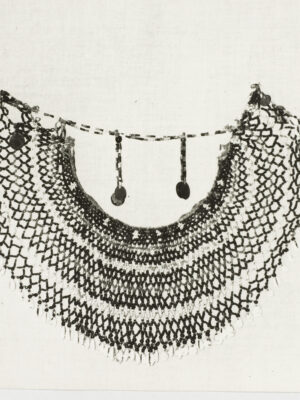
I lost my neckless stories
Last summer, I visited the woman who still knows how to thread beads into elaborate necklaces like this one. The myriad tiny pearls are called kudrused. The maker goes by the name of Ella. She lives on a tiny island called Kihnu, which now falls under the national territory of Estonia.
When I arrived at her home, I found a wooden branch resting on her doorstep. I was told this means she is not at home. ‘A local custom,’ they said. So, I stood there, confused. I thought about all the possible stories she could have told me. About how she would pass the ancestral knowledge down to me and make me the next sole person to master this vanishing craft. How I would move to this island and…
When I did meet Ella the next day, she showed little interest in me. Perhaps because of her old age, or maybe because to her, I was yet another outsider. Ella’s daughter opened the doors to a shed where they run a tiny crafts shop, filled with garments of traditional cut, produced from fabrics they order from Asia. She sold me a set of kudrused made from cheap colourful beads. She was not shy when she announced, ‘Ordered from Alibaba.’
I realised that it is I who read meaning into their craft, who spoil it with contextualisation. It is I who see the use of non-local fabrics with local techniques as a reflection of the current social and economic order. For them, of course, this is not a precious ancestral craft but just a normal way to sew clothes, just an ordinary method for setting beads into necklaces.
This article is part of a larger exploratory series called Urban Mythology commissioned by Current Obsession. The theme blends personal mythology and modernised traditions to present a new take on identity, oral history, and symbolic language. Reclaiming history and decolonising the past and future through innovative narratives and in-depth research, it examines anything from beliefs, (cyber) deities, folklore, shamanism, to the creative prowess of multicultural artists. Diving into a world where ethereality meets living jewellery, where history is not just retold but reimagined. Urban Mythology seeks to explore the richness of our past and present, redefining our traditions and propelling us towards an uncharted future.
Cover image: Wedding jewellery. Pulmarõivad. Ehted. (ERM Fk 2223:29); Eesti Rahva Muuseum; 178845_ERM_Fk2223_29_178845.jpg
